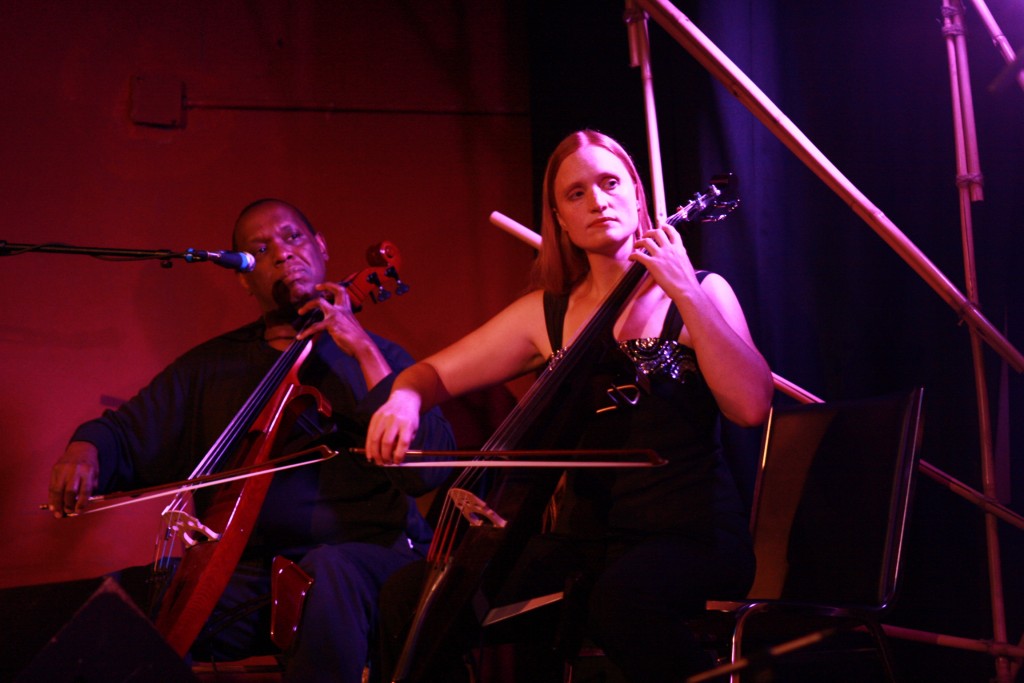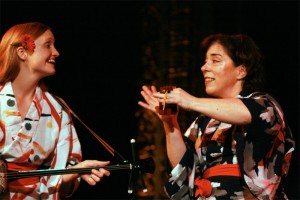Author’s note: I wrote the following shortly after our 15th anniversary concert (reVISION on May 30 and 31), but found myself feeling shy about sharing this with the world, so I didn’t publish it right away.
Just over a week has passed since ONE’s 15th anniversary concert, reVISION. Everyday life is flowing by so fast that I haven’t had much chance to reflect on the experience. It fades into the past so quickly…
reVISION was probably the most challenging performance I’ve done as a taiko player– in large part because I wasn’t just playing taiko.
I played 4 different instruments: electric cello, sanshin, chudaiko, and kane.
Electric Cello
(The Biggest Challenge)

Nowaki with Marshall Hughes. This was a richly layered song involving taiko, violin, voice, and cello. Photo by Joe Foley.
I played cello for 9 years (from age 9 to 18). At the time, I didn’t have the discipline to practice enough at home, though from 7th through 12th grades I played with the school orchestra for an hour 5 days a week. One reason I didn’t practice enough was that I didn’t believe that I could tell when I was in tune–I always felt like others could hear something that I couldn’t. I’ve since learned that I can hear, but that it takes training and practice to be able to hear and respond while playing.
In other respects I lacked confidence as a cellist– especially the longer I played, the more I noticed what I did wrong. I got more and more nervous about soloing, though I still really enjoyed playing with my high school orchestra. (Hmm, and now I prefer kumidaiko to soloing.)
I could go on about my past life as a cellist, but the main thing is that I stopped. I went to college and, for many years, I rarely touched my cello. Then one day Cat revealed that she wanted to learn to play her super cool electric cello. I agreed to teach her in exchange for the motivation to practice again.
Fast forward a year and a half, and Mark is putting together a couple of exciting new songs for our 15th anniversary concert, and the new songs involve cello! So, along with guest artist Marshall Hughes, I got to play cello in reVISION. It was great to be able to perform on a cello again, though remarkably after all these years, the same fears and anxieties resurfaced.
Sometimes It’s Okay to Stand Aside
Those fears were okay when it came to playing the relatively simple, but utterly cool cello parts in the Intro, Kaminari, and Nowaki. However, there was one song I wasn’t ready for. The ensemble played “To Fly” written by Ann Ishimaru of Portland Taiko, which has an absolutely gorgeous melody part originally written for fue and violin. We were going to play it as violin and cello. On somewhat short notice, I was assigned the cello part, which could have harmonized beautifully with guest artist Yael Bat-Shimon‘s violin.
I practiced on my own quite a lot, had some extra practice with Yael, and found that while I can play pretty nicely in tune and in tempo on my own, it becomes much more difficult to play with others… especially very loud drums. Even with an amped electric cello, it was very difficult to hear myself over the drums, match pitch with Yael, and keep up with the tempo. My old fears resurfaced. I needed to practice a lot, and due to the nature of my profession (landscape designer), this is the most challenging time of year to find the time.
I found some time, but not enough. In the end, I realized that I wasn’t quite ready and felt too much stress about it. So, I discussed it with Yael and then Mark, finally asking to be relieved of the job. The piece was lovely with Yael alone, and I was so relieved, it made everything else seem a lot easier afterward.
It was really difficult to face the fact that I didn’t feel ready, I was worried that I would be disappointing Mark and Juni, that I would be messing things up for the song… but I knew in my heart that this time, it would be better without me, and I would be better in everything else without it. I feel very fortunate that I could talk with Mark about my fear, and he made it easy on me.
Sanshin
(My Newest Instrument)
I picked up sanshin in September 2008, while visiting the Kodo Apprentice Center. So, I’ve played sanshin for less than a year, and somehow it is much less stressful to play than the instrument I’ve played the longest. Strange, but true.
I was paired with Diane for “Island Stroll,” a somewhat improvised cheerful tune that was placed to cover the transition between two other songs. Diane played a swing beat on a sanban, and I played my own tune on my sanshin.
It’s not easy to be one of only 2 people onstage, but I had a lot of fun interacting with Diane. I did feel very exposed, so I think I may not have been as lively as I’d like, but I think we pulled it off! At least we look like we are enjoying ourselves in the pictures.
Chudaiko
(Finally Beginning to Relax)
I got to play chu in the opening of the second act. It was Hamon– Mark’s intricate and energetic composition, which we first began learning about a year ago.
I love playing Hamon. I love playing chudaiko on a tate stand. I feel really good when I do.
Mark wrote Hamon when he was living in Japan several years ago, and it is a remarkable composition. He used rhythms from rock songs (especially one in particular from Michael Jackson), and created a dynamic piece in four parts. The interplay between the parts works marvelously.
Because we’ve been rehearsing it for so long, I really feel like it has seeped into my body. I don’t have to think as hard now. I do still need to focus, and there are challenging parts that warrant frequent practice…. but I feel the song.
Kane
(The Finale)
The last song in the concert was a reprise of Shin-en, with all of the ONE community members participating. I got to dance through the audience playing kane.
Clang, clang!




